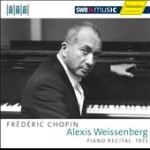The main difference between Alexis Weissenberg’s generally forceful yet charmless and bleak 1972 Schwetzinger Festival Chopin performances and their EMI studio counterparts is that the SWR engineers reveal more color and heft to the pianist’s steel-edged sonority in comparison with EMI’s tinny, monochrome pickup. The pianist’s stern, headlong, occasionally overpedaled sprint through the B minor’s first movement is at far remove from Chopin’s Maestoso directive, while the Scherzo outer sections’ right-hand figurations, though note perfect, lack suppleness and melodic direction, as do the Finale’s rushed phrase ends. At least the grim, unlyrical EMI studio Polonaise-Fantasie contains a modicum of breadth and breathing room in the final pages, in contrast to the present version’s damn-the-torpedos-full-steam-ahead gait.
Fortunately Weissenberg’s lyrical potential vis-à-vis the Nocturnes is realized to a far greater degree than in his relatively two-dimensional EMI versions. Listen to the B major Op. 9 No. 3’s tellingly shaped legato lines, or to the patient intensity with which the C minor Op. 48 No. 1’s central climax builds from the slow processional music that comes before. Similarly, the D-flat Op. 27 No. 2 main theme’s rubato seems more fluid and less calculated here.
The Fourth Ballade fascinates in Weissenberg’s hands (he did not record it in the studio, as far as I know). Favoring an unusually brisk basic tempo (more “con moto” than “andante”, that’s for sure!), the pianist arpeggiates select left-hand chords and makes an unwritten piu mosso at the G-flat major theme from measure 38 that undermines the music’s hushed mystery. However, Weissenberg pays uncommon heed to the contrapuntal implications within the thick textures starting at measure 100. The headlong coda features several hair-raising crescendos that convey a whiplash impact worthy of Vladimir Horowitz in his prime. In sum, Weissenberg’s Chopin holds your attention, but it’s not easy to love. [7/11/2011]
































